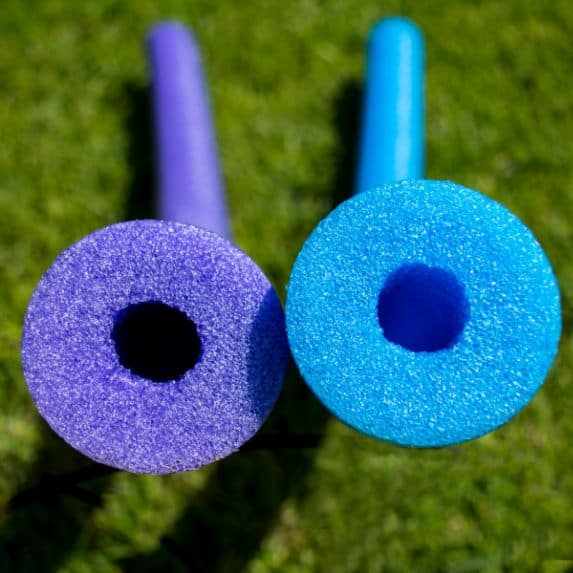Creative Learning Activities at Home
Did you know that a simple, affordable, and readily available item that you often find floating in pools could revolutionize your homeschool curriculum? Enter the versatile pool noodle. Far from being just a pool-side plaything, using pool noodles to teach is an excellent idea for hands-on learning that’s both creative and much fun. Here are four dynamic pool noodle games and learning activities for kids that you can integrate into your homeschool curriculum, and these pool noodle ideas are a perfect way to get older kids and younger kids engaged in learning.
Where to buy pool noodles: One of the best places to find pool noodles is at your local dollar store. However, pool noodles can also be found at big box retailers such as Wal-Mart and Target. This is definitely frugal fun with a simple pool noodle. You can expect to find pool noodles when summer items appear in the stores. But more retailers are carrying pool noodles year-round.

Math
Who said math had to be boring? With pool noodles, homeschoolers can explore shapes, patterns, and even the concept of fractions in a colorful and tangible way. Cut pool noodles into various lengths to spark discussions on long and short, or use different colors to create patterns and sequences.
For older students, you can use pool noodles in your classroom as tools for crafting number lines and demonstrating addition or subtraction. The soft, pliable texture of the noodle makes it perfect for shaping numbers and geometric figures, appealing to tactile learners who grasp concepts through touch and manipulation.
Language
In the realm of language and literacy, the alphabet is a gateway to learning, and pool noodles can serve as a bridge. You can cut noodles into sections and put a letter on each of the pool noodle pieces, allowing spelling games to become interactive and fun. There are many different ways to use pool noodles for spelling including using a wooden dowel to put pieces of pool noodle on. On each piece, write letters around the slice with a permanent marker. You can easily get 3-4 letters written. Start with 3 letter words with the vowels in the center. This is a fun way to learn new words!
Also, kids can jump, hop, and step their way through a pool noodle obstacle course, spelling words as they go.
The activity makes the typically static experience of learning to spell a dynamic and athletic adventure, engaging both body and mind. For younger students, stringing pool noodle letters onto a wooden dowel can simulate the formation of words, reinforcing the concept of letter order and sounds.
Science
Science comes alive through observation and experimentation. With pool noodles, the world of scientific discovery becomes accessible and exciting. Create a floating and sinking experiment by cutting different shapes of noodles, adding various other elements to each piece, and predicting their buoyancy.
You can transform a pool noodle into a rocket by adding a straw and balloon, creating a simple but thrilling lesson on propulsion. The buoyant and resilient nature of pool noodles encourages hands-on engagement in water-related science and demonstrates concepts like force, motion, and even engineering principles.
For a fun stem challenge use shaving cream as “cement” and various sizes of pool noodle pieces to build towers, bridges, and other engineering masterpieces. When you are all done building, simply wash away the shaving cream.
Physical Development
Pool noodles make it easy to combine physical activity and academics. Construct an obstacle course using pool noodles to encourage motor skills development in a playful setting. Weave through noodle tunnels, hop over noodle hurdles, and balance on noodle pathways.
Another great way to use pool noodles for gym is by cutting them in half and using them as “swords” to hit a beach ball. Play a game of keep the ball in the air as long as possible.
This kind of physical engagement not only supports the development of gross motor skills but also integrates learning into a child’s natural play. Hopping from one noodle to the next can involve counting, letter recognition, or even a quick spelling challenge, ensuring that movement and learning align for a holistic experience.
Using Pool Noodles to Teach with Sensory Play
You can also incorporate fine motor skills using pool noodles. Cut the pool noodles into 1 to 2″ slices. Using yarn, string the pool noodles onto the yarn, creating giant necklaces.
Young children love sensory play. Furthermore, creating a sensory bin with pieces of pool noodles creates less mess than sand or stones. Little hands will love the feel of the pool noodles while they dig for buried treasures. Additionally, you can add pieces of pool noodles in water, shaving cream, or slime for more fun pool noodle activities. Keep in mind that older kids with sensory needs may love the same types of bins. Just make sure to place their favorite toys or characters in the bins.
Arts and Crafts
Using pool noodles to make arts and crafts just makes sense.
Great pool noodle crafts include:
- 2-3″ pieces of pool noodles with googly eyes, pipe cleaners, popsicle sticks – create monsters, spiders and bugs, pets, and more.
- Make sailboats
- Rockets
- Stick Horses
Additionally, using the foam noodles to paint is a fun idea. You can wrap different textured items around the end of a short piece and attach with a rubber band. For example: bubble wrap, nylon net, or other cloth or mesh and dip in paint. Make pictures!
History
Yes, you can also teach history with the pool noodle. Research when the pool noodles were developed and who developed them.
Pool noodles present an excellent opportunity for homeschoolers to infuse fun and creativity into their educational activities. With these pool noodle learning activities for kids, students can benefit from enhanced learning experiences in math, language, science, and physical development. These activities not only make learning more fun but also help in developing crucial skills that will serve children throughout their educational journeys.

Reviewing movies for parents from a Christian perspective since 2005. Know Before You Go!
Christian Homeschooling mom – 30 years and counting
Autism Mom & Disney enthusiast
